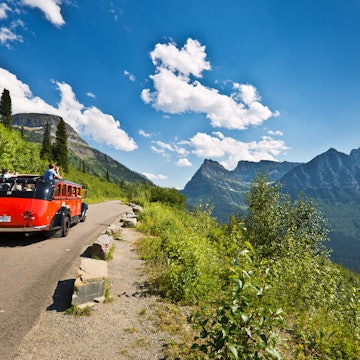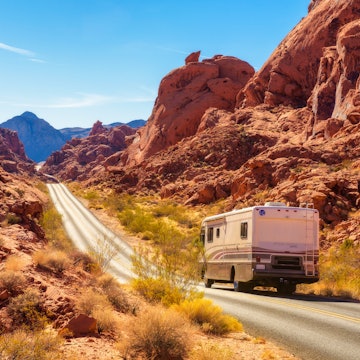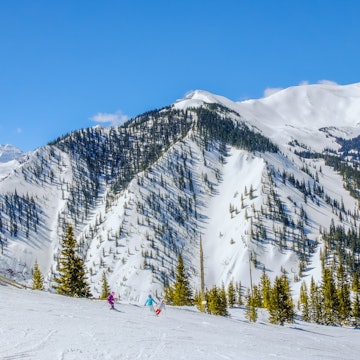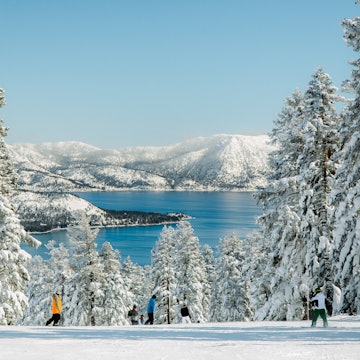

Red Rocks Park & Amphitheatre is one of America's most iconic venues. John P Kelly/Getty Images
Wedged between two towering, 300ft-high fins of red sandstone, Red Rocks Park & Amphitheatre may well be the world’s most iconic outdoor concert venue. Renowned for its natural acoustics and stunning beauty, this landmark stage on the southeastern fringes of Denver has become synonymous with big-ticket concerts from the likes of The Beatles, Jimi Hendrix, The Grateful Dead, James Taylor, U2, Radiohead and Coldplay.
There’s something almost primal about attending a concert at Red Rocks – the sound of music reverberating off the bare rock, the sight of people dancing in the stacked terraces, the curtain of dark sky above, and the iconic red sandstone monoliths standing guard on either side. Indeed, for many, it’s a reason to visit Colorado all by itself.
But even if you can’t make a show, the venue and the 816 acres of parkland that surround it are free to visit and well worth the 15-mile trek from Denver. Here’s everything you need to know about visiting Red Rocks Park & Amphitheatre, Colorado.
What’s the history of Red Rocks Park & Amphitheatre?
Red Rocks was once a sacred gathering place of the Ute people, the Indigenous inhabitants of the Great Basin and Colorado Plateau. After the region was colonized by European settlers, this natural basin continued to play an important role in local life and it was converted into a public park in 1878. The rocky basin was later used informally as a makeshift performance space, before the city of Denver purchased the land and built a stage and seating in 1927.
The debut show on this crag-framed stage was by the lyric soprano Helen Jepson in 1941. It took a further 23 years before its owners made the logical leap of hosting rock music in an amphitheater made of rock. In 1964, Red Rocks debuted as a rock venue, and it did so in style, featuring The Beatles on their first US tour.
Since then, Red Rocks has hosted some of the biggest names in rock, country, soul and other popular genres – including Blues Traveler, who have played here almost every Fourth of July since 1993, and Widespread Panic, who have clocked up more than 70 shows in this legendary venue.

Why is Red Rocks red?
The red color of the rocks at Red Rocks Amphitheatre is the result of iron oxide, or rust, naturally present in the local sandstone. Over 300 million years ago, sedimentary rock containing iron formed, and exposure to oxygen turned it a rich, brick red. Geological forces later thrust the rocks upward, creating the iconic formations seen today.
How do I get tickets for a concert at Red Rocks?
The quintessential Red Rocks experience is taking in a live performance. From April to November, the venue hosts a packed schedule of big-name musicians, symphony orchestras and solo artists; bands like U2 and the Grateful Dead have even recorded live albums here. However, despite being a big venue, shows often sell out quickly – sometimes within minutes of tickets going on sale.
Tickets are sold through AXS.com, but you can save on service fees if you buy directly from the on-site box office or at Denver’s Coliseum. Seating is on wide, wooden terrace benches built into the amphitheater’s steep natural incline, with more than 9500 seats spread across 70 rows.
There are no bad seats! The lower the number, the closer to the stage; the higher the number, the better the views. Concerts typically start at sunset, with the rocks aglow and city lights twinkling beyond. If you come earlier in the day, you can explore the rock formations, take a hike and have dinner before the show. Read up on upcoming shows on the official Red Rocks website.
What should I eat and drink on a trip to Red Rocks?
During shows, concession stands at the venue serve everything from pizzas and pasta and Greek gyros to chicken sandwiches, tacos, smoky BBQs, fries, corn dogs, funnel cakes and more. For drinks, take your pick from coffee, cold beers, alcoholic and non-alcoholic smoothies and plenty of other refreshments.
For daytime sit-down dining, make a reservation for the Ship Rock Grille, open 10:30am to 2:30pm – or for a drink with a rocky landscape view, head to the Row 71 bar. There are more places to eat and drink near the junction of Bear Creek Ave and State Hwy 93.
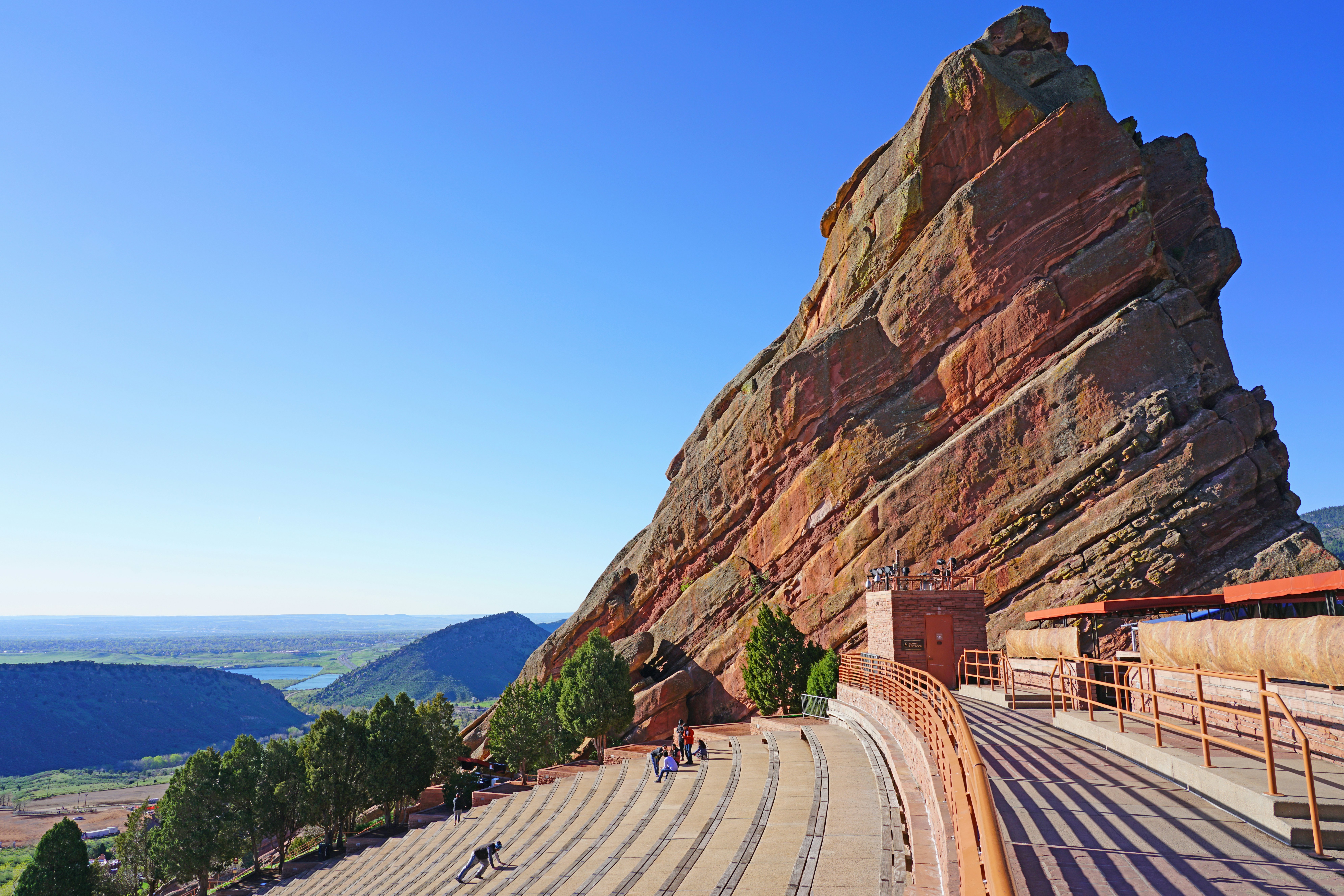
What else can I do at Red Rocks Park & Amphitheatre?
Taking in a show is just the start of the Red Rocks experience. Before the performance – or even if you skip taking in a show completely – there are lots of other ways to enjoy this iconic setting. Indeed, it's one of the most popular things to do in Colorado.
Catch a film screening at Red Rocks
If a concert isn’t on the cards, Films on the Rocks is a fun runner-up. On set summer evenings, the Denver Film Society projects classic and cult films onto a huge screen, converting the venue into a large-scale outdoor movie theater.
Screenings are packed with locals on blankets, noshing and chitchatting, and there’s a laid-back community vibe. Pre-show performances by up-and-coming comedians and bands kick off the evening, then, as the sunlight fades and the stars emerge, the movie begins.
Join a Red Rocks yoga session
If morning is your jam, come at sunrise for Yoga on the Rocks. At this regularly scheduled summer weekend class, thousands of yogis set up their mats along the amphitheater’s terraced seating. It’s one of the most memorable spots in America to practice your downward dog.
Led by some of Denver’s top yoga instructors, the all-levels classes cost around the same as a drop-in class in town, but the peaceful outdoor setting is unmatched. The morning air, the expansive views and the sun rising over the red rock all add to a sense of tranquility and connection. Bring your own yoga mat.
Take in the (free) views
In addition to being a world-class concert venue, Red Rocks is also a Denver Mountain Park, one of a handful of parks located within 60 miles of Denver that is maintained by the city authorities. Because of this, the amphitheater and the land surrounding it are free to visit and open to the public from sunrise to sunset.
Come during the day to wander through the theater, snap photos next to the stage (or on the stage if you’re lucky!) and admire the iconic monoliths – Ship Rock and Creation Rock – that help create the remarkable acoustics. You can also join locals working out on the steep stairs, a common sight year-round.
To take in Red Rocks’ famous 360-degree panoramic views, head to the landing above the highest row of seats. Note that on event nights, the amphitheater closes at 2pm.

Hit the Red Rock hiking trails
Red Rocks has a collection of walking trails winding through its 800-plus acres. Each showcases the park’s stunning geology, offering sweeping views extending to downtown Denver. Most have interpretive signs that detail the area’s history, geology and plant life.
For a moderately easy hike, try Trading Post Trail, a 1.4-mile loop weaving through the heart of the park, past meadows and between towering red rock formations. The trail starts at the namesake Trading Post, a historic building with a souvenir shop, snack bar and bathrooms – perfect for a pre- or post-hike pitstop.
For a longer, more strenuous hike, hit Red Rocks Trail – a 6-mile out-and-back hike that begins near the lower north parking lot and connects to the Morrison Slide Trail in the neighboring Matthews Winters Park. The trail climbs through rocky terrain to higher elevations with views of the foothills and mountains beyond; sightings of prairie dogs, red foxes and mule deer are common in the early mornings and late afternoons.
Alternatively, take the Red Rocks Trail to the Dakota Ridge Trail, an out-and-back 4-mile route that follows the rocky spine of Dinosaur Ridge. Whatever trail you choose, remember to stay hydrated, an important consideration at this elevation; look for fill stations at the visitor center and inside the venue. Note that you may encounter horse riders and mountain bikers on the multi-use Red Rocks Trail.
Check out Red Rocks’ Hall of Fame
You can learn all about the artists and performances that have shaped the legacy of Red Rocks Amphitheatre at the free-to-visit Red Rocks Hall of Fame. Located inside the visitor center, the exhibits provide some fascinating background on the long list of artists who have given concerts at Red Rocks since 1947.
Expect memorabilia such as instruments, costumes and posters from past performances (here’s looking at you, John Denver and Jimi Hendrix). You can also stop at listening stations to hear music by inductees, and learn all about the history of the locale. It’s not the Smithsonian, but it’s worth a stop.
Is Red Rocks accessible?
Two rows of seating at Red Rocks are wheelchair accessible for shows and screenings, and other rows are set aside for people with limited mobility and visitors with a visual or hearing impairment. There’s a dedicated accessible shuttle for visitors with disabilities during events.
Top tips for visiting Red Rocks Park & Amphitheatre
You’ll have a more rewarding visit if you follow these tips.
Arrive early – tailgating is a pre-concert hassle, and you’ll also avoid the bumper-to-bumper traffic.
Be ready for some uphill walking; parking is on a steep hillside below the amphitheater and the seating is on a slope.
Wear layers – even in summer, temperatures drop quickly after sunset.
Bring a credit card, as the venue is cashless; this also applies to the ambulant vendors.
Consider taking a round-trip shuttle from Denver ($60 per person); it’s pricey but convenient.
Smoke weed (or pop gummies) at your own risk. You’ll see plenty of folks lighting up, but while the use of marijuana has been legalized in Colorado, it’s illegal to partake in public.
This article was adapted from Lonely Planet’s Colorado guidebook, published August 2025.








